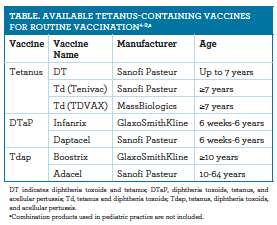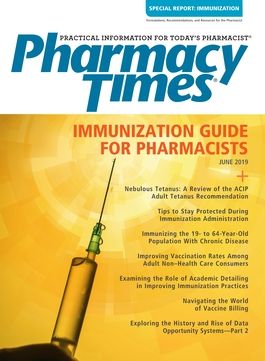Nebulous Tetanus: A Review of the ACIP Adult Tetanus Recommendation
In the confusing and changing world of immunizations, the question of which tetanus vaccine to provide challenges a pharmacist's ability to protect patients.
In the confusing and changing world of immunizations, the question of which tetanus vaccine to provide challenges a pharmacist’s ability to protect patients. Add to that the difficulty in obtaining accurate immunization records for adult patients, and the struggle is amplified. Questions that plague pharmacists include, “What does a provider do when a patient cannot recall infor- mation regarding their last dose of tetanus?” “Did the patient receive the Tdap (tetanus, diphtheria toxoids, and pertussis) vaccine or a Td (tetanus and diphtheria toxoids) booster?” “Was the vaccine given during pregnancy?” “When was the last time the patient received the vaccine?” These questions are even more difficult for a pharmacist to answer in the moment.
Even with registry access and provider consultations, last-dose information may still be unavailable. With immunization rates for adults being low1, it is critical that pharmacists be able to make confident recommendations to their patients. The purpose of this article is to clear up any confusion pharmacists have regarding tetanus vaccines in adults and enable them to make informed decisions when immunizing patients and stocking their pharmacies.
Clostridium tetani, the microorganism that causes tetanus, enters the body through an open wound. Tetanus is caused by the exotoxin produced by the bacterium, which is released into the bloodstream and lymphatic system. Because the bacterium is anaerobic, it germinates in low-oxygen conditions. The exotoxin leads to nervous system disruption and causes muscle contractions and spasms.2 Characterized by overall muscle rigidity, commonly known as “lockjaw” due to a tightening of the jaw muscles, tetanus presents acutely and can be fatal if untreated.3
The importance of tetanus vaccination in adults is evident when considering the incidence of dis- ease. Tetanus primarily occurs in adults at a median age of 44 years, and most patients are unvaccinated or inadequately vaccinated.1
The Advisory Committee on Immunization Practices (ACIP) recommended immunization schedule for routine vaccination in adults is 1 dose of the Tdap vaccine, followed by a Td booster every 10 years for patients who did not receive at least 1 dose of the Tdap vaccine at or after age 11.4 Many adults, however, do not know which vaccine they received or when they received it. Furthermore, there are a range of tetanus-containing vaccines available for a pharmacist to provide patients (see table).4-9

Pharmacists must help patients determine which vaccine they received previously so they can ensure the correct follow-up dose is administered and in stock, as most pharmacies do not carry multiple forms of the vaccine. This is espe- cially important because recommen- dations from the ACIP have slightly changed over the past 6 years due to changes in the recommendations for wound management administration and the addition of a recommendation for women to receive the Tdap vaccine during each pregnancy.
In 2013, data reviewed by the ACIP indicated that a second dose of Tdap was safe and effective for protection against tetanus and pertussis; however, this recommendation was not accepted because of cost concerns.10
During their October 2018 meeting, the ACIP again reviewed the recommendation for a second dose of Tdap. This review stemmed from concerns regarding the lower vaccination rates seen in adults: Roughly just 20% of eligible adults are vaccinated with Tdap.11 This was coupled with the additional concern that adults are experiencing decreases in pertussis coverage over time, with waning immunity demonstrated 2 to 4 years after vaccination.12-19 In addition, the ACIP noted that many providers are not currently stocking multiple tetanus-containing vaccines. Broadening the recommendation to allow for any tetanus-containing vaccine would ease administration barriers for providers.
Also at the meeting, Sanofi Pasteur, maker of the Tdap vaccine Adacel, presented data showing that the administration of a repeated Adacel dose—8 to 12 years after an initial dose—was safe and effective. They also noted that health care providers are seeking guidance on which tetanus product to use in the event that a patient’s previous vaccination type is unknown. They concluded that approval of a repeated dose would help health care providers to more efficiently ensure adults are up-to-date with their vaccinations.20
GlaxoSmithKline, maker of the Tdap vaccine Boostrix, pre- sented similar data. Repeated administration of Boostrix in patients aged 19 through 73 was shown to be both immunogenic and well tolerated.21
Although the ACIP did not firmly recommend administration of Tdap every 10 years, following this meeting, the vaccine manufacturers are looking to the FDA for approval. Based on provider comments, it appears that embracing the administration of any tetanus-containing vaccine as the follow-up dose would improve vaccination rates for adults. This change would allow providers to determine which vaccine, Td or Tdap, to administer to the patient without having to worry about which vaccine was in stock. Until the ACIP updates their recommendations, or the FDA approves the repeated administration with any vaccine type, pharmacists should continue to follow the ACIP routine vaccination schedule for adults: 1 dose of the Tdap vaccine, followed by a Td booster every 10 years in patients who did not receive at least 1 dose of the Tdap vaccine at or after age 11.
CHRIS ALTMAN, PHARMD, is the clinical manager for immunizations at Rite Aid in Harrisburg, Pennsylvania.
REFERENCES
- Liang JL, Tiwari T, Moro P, et al. Prevention of pertussis, tetanus, and diphtheria with vaccines in the United States: recommendations of the Advisory Committee on Immunization Practices (ACIP). MMWR Recomm Rep 2018;67 (-2):1-44. doi: 10.15585/mmwr.rr6702a1.
- Tetanus: symptoms and complications. CDC website. cdc.gov/tetanus/about/ symptoms-complications.html. Accessed April 2, 2019.
- Centers for Disease Control and Prevention. Tetanus. In: Epidemiology and Prevention of Vaccine-Preventable Diseases. The Pink Book. Hamborsky J, Kroger A, Wolfe S, eds. 13th ed. Washington DC: Public Health Foundation; 2015:341-352. cdc.gov/vaccines/pubs/pinkbook/tetanus.html.
- Immunization schedules. Tetanus, diphtheria, and pertussis vaccination. CDC website. cdc.gov/vaccines/schedules/hcp/imz/adult.html#note-tdap. Updated February 5, 2019. Accessed April 2, 2019.
- Diphtheria and tetanus toxoids adsorbed [prescribing information]. Swiftwater, PA: Sanofi Pasteur Inc; 2018. fda.gov/media/75962/download. Accessed April 29, 2019.
- Tenivac [prescribing information]. Swiftwater, PA: Sanofi Pasteur Inc; 2013. vaccineshoppe.com/image.cfm?doc_id=12609&image_type=product_pdf. Accessed April 29, 2019.
- Tetanus and diphtheria toxoids adsorbed TDVAX [prescribing information]. Boston, MA: MassBiologics; 2018. fda.gov/media/76430/download. Accessed April 29, 2019.
- BOOSTRIX [prescribing information]. Research Triangle Park, NC: GlaxoSmithKline. fda.gov/media/76633/download. Accessed April 29, 2019.
- Adacel [prescribing information]. Swiftwater, PA: Sanofi Pasteur Inc; 2019. fda.gov/media/119862/download. Accessed April 29, 2019.
- Advisory Committee on Immunization Practices. Summary Report: June 19-20, 2013. Atlanta, GA: US Department of Health and Human Services and the CDC; 2013. cdc.gov/vaccines/acip/meetings/downloads/min-archive/min-jun13. pdf. Accessed April 2, 2019.
- Vaccination Coverage Among Adults in the United States, National Health Interview Survey, 2016. CDC website. cdc.gov/vaccines/imz-managers/cover- age/adultvaxview/pubs-resources/NHIS-2016.html. Updated February 26, 2018. Accessed April 9, 2019.
- Gustafsson L, Hallander HO, Olin P, Reizenstein E, Storsaeter J. A controlled trial of a two-component acellular, a five-component acellular, and a whole-cell pertussis vaccine. N Engl J Med. 1996;334(6):349-355.
- Rank C, Quinn HE, McIntyre PB. Pertussis vaccine effectiveness after mass immunization of high school students in Australia. Pediatr Infect Dis J. 2009;28(2):152-153. doi: 10.1097/INF.0b013e318185608e.
- Schmitt HJ, von König CH, Neiss A, et al. Efficacy of acellular pertussis vaccine in early childhood after household exposure. JAMA. 1996;275(1):37-41.
- Wei SC, Tatti K, Cushing K, et al. Effectiveness of adolescent and adult tetanus, reduced-dose diphtheria, and acellular pertussis vaccine against pertussis. Clin Infect Dis. 2010;51(3):315-321. doi: 10.1086/653938.
- Pichichero ME, Rennels MB, Edwards KM, et al. Combined tetanus, diphtheria, and 5-component pertussis vaccine for use in adolescents and adults [erratum in JAMA. 2005;294(24):3092]. JAMA. 2005;293(24):3003-3011.
- Ward JI, Cherry JD, Chang SJ, et al; APERT Study Group. Efficacy of an acellular pertussis vaccine among adolescents and adults. N Engl J Med. 2005;353(15):1555-1563.
- Acosta AM, DeBolt C, Tasslimi A, et al. Tdap vaccine effectiveness in adolescents during the 2012 Washington State pertussis epidemic. Pediatrics. 2015;135(6):981-989. doi: 10.1542/peds.2014-3358.
- Breakwell L, Kelso P, Finley C, et al. Pertussis vaccine effectiveness in the setting of pertactin-deficient pertussis. Pediatrics. 2016;137(5). doi: 10.1542/peds.2015-3973.
- Greenberg D. Safety and immunogenicity in adults of revaccination with Adacel vaccine 8-12 years after a previous dose. Presented at: Advisory Committee on Immunization Practices (ACIP) Meeting; October 24-25, 2018; Atlanta, GA. cdc.gov/vaccines/acip/meetings/downloads/slides-2018-10/Pertussis-03-Greenberg-Sanofi-508.pdf. Accessed April 2, 2019.
- Silverstein L. Boostrix revaccination studies at 9-10 years — Studies 009 & 012. Presented at: Advisory Committee on Immunization Practices (ACIP) Meeting; October 24-25, 2018; Atlanta, GA. cdc.gov/vaccines/acip/meetings/downloads/slides-2018-10/Pertussis-04-Silverstein-GSK-508.pdf. Accessed April 2, 2019.

